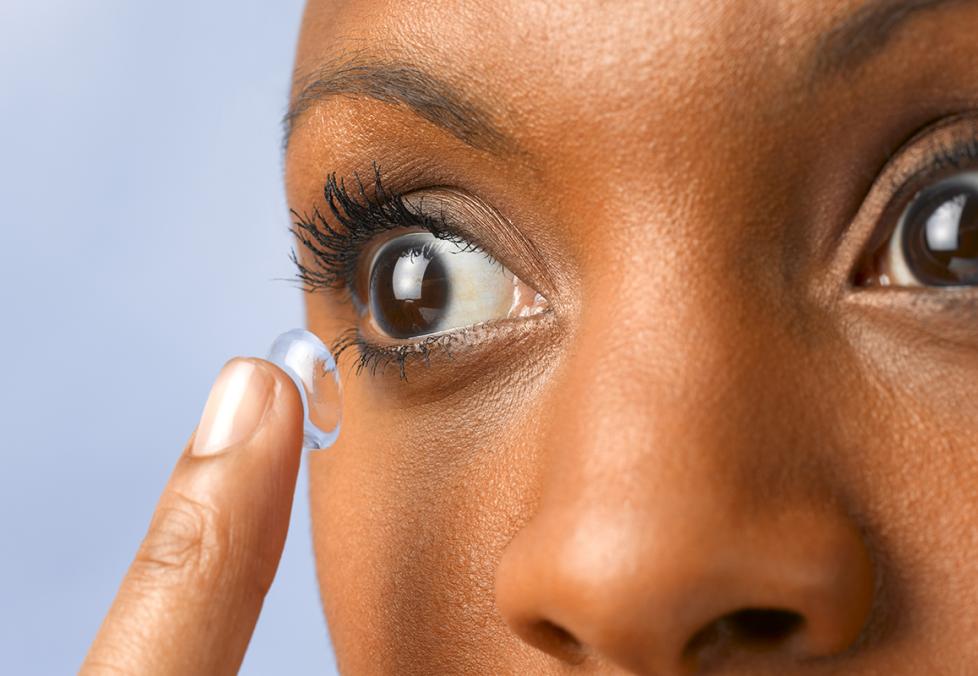
GreenLove frames made from recycled materials. Plastic-neutral contact lenses. We're committed to keeping our environmental impact low.
Everything you need to know to take care of your eyes — for life.

There are a lot of misbeliefs out there about contact lenses. They can get lost behind your eye! They can fuse to your cornea! They’re dangerous!
There are about 45 million Americans who currently wear contact lenses. But according to a 2022 Contact Lens Institute survey, many people hold mistaken beliefs about contacts.
The truth, however, is that contacts can be worn safely and comfortably.
Here are the facts behind some of the most common misbeliefs.
Did you know that contact lens prescriptions need to be renewed every year? Find an exam time that fits your schedule.
The truth: That can’t happen!
Recently lost a contact lens? Don’t worry, it’s not floating inside your head next to your brain.
The surface of your eye is covered with a clear membrane called the conjunctiva. It extends over the front of the eye and onto the eyelid, preventing contact lenses from leaving the front surface of the eye area.
“It’s a closed environment,” says Jennifer Palombi, O.D., a contact lens specialist and spokesperson for CooperVision, a global leader in contact lenses, including Sofmed, with the widest range of prescription options. “Your contact can’t go any higher than the top part of the lid.”
If one of your contacts has traveled somewhere in your eye and you can’t find it, it may have gotten stuck at the top of your inner eyelid, she says.
To loosen it up, rinse your eye with sterile saline solution or rewetting drops. (Tap water is not good for contact lenses.) Then massage the eyelid with small circular motions, which can help work the lens back down.
The truth: Contacts can become drier, but they won’t become immovable.
No, your contacts won’t fuse to your eyeball, says Dr. Palombi. What is common, however, is that contact lenses can become dry. That, in turn, may make them a bit difficult to take out.
Dr. Palombi says this happens most often if you’ve worn them for too long or for too many days in a row.
“A good rinse of the eye with sterile saline or rewetting drops will help rehydrate that lens and loosen it up so that it will come out,” says Dr. Palombi.
To prevent it from happening in the first place, it’s a good idea to get in the habit of using rewetting drops once or twice during the day. It’s especially helpful if you’re in a dry environment — such as an arid climate or a highly air-conditioned building.
The truth: Contacts are safe, as long as you wear them as prescribed.
Contact lenses have been approved by the U.S. Food and Drug Administration, so they can certainly be worn safely. But that doesn’t mean they can be worn carelessly, says Dr. Palombi.
Wearing your contacts for too long — say, trying to wear them for a few days past their expiration date, for example, or dozing off in lenses that aren’t specifically approved for sleep — can increase your odds of complications.
You may experience:
Learn more about the downside of pushing your contact lenses past their limit: Ask an Optometrist: Is it bad if I wear my monthly contact lenses more than 30 days?
You also need to take care of your contacts properly, says Dr. Palombi. Here’s what to do:
Read more Care Tips for Contact Lenses.
The truth: A wide range of contact lenses are available to meet a wide range of vision needs.
One reason that contact lens prescriptions need to be reviewed and renewed every year is that your vision can change — as can your eye health and lifestyle needs.
Because of that, your eye doctor will weigh the pros and cons of dozens of different lenses before discussing the options with you, says Dr. Palombi.
“Part of the reason that contacts are medical devices that are regulated by the FDA is because there are so many differences between them,” explains Dr. Palombi. “What makes one lens appropriate for one patient may not be right for another.”
As part of your eye exam, the optometrist will think about the many different types of lenses, including:
Each type of lens is then customized to correct your vision and fit the curve of your eye.
Learn more by reading America’s Best Guide to Contact Lenses. And browse America’s Best contact lens options.
The truth: Many kids can wear them, and for some it’s recommended.
Parents can be hesitant to let their child wear contact lenses, but the truth is, some research has shown that children as young as 8 can successfully wear contact lenses. What’s more, their vision may benefit from wearing contacts instead of eyeglasses.
A study found that kids ages 8 to 11 are actually less likely to experience complications from wearing soft contact lenses than adults or teenagers are. One likely reason: Younger children may be more likely to comply with good contact lens hygiene habits than, say, teenagers, says Dr. Palombi.
There’s also a good reason to introduce certain contact lenses earlier rather than later. MiSight contacts from CooperVision, for example, can slow the progression of myopia (nearsightedness) in children who start wearing them between the ages of 8 and 12. The lenses correct the child’s vision, allowing them to see clearly, and they can also help prevent the eye from lengthening, which worsens myopia.
Learn more about kids and contact lenses by reading 5 Lesser-Known Facts About Contact Lenses for Kids.
The truth: You should always take out your contacts in the pool — even if you’re wearing goggles.
Let’s be honest: Goggles don’t keep every drop of water out of your eyes. And if your goggles leak, water can get inside, causing the lenses to swell or change shape. That, in turn, can scratch the outer part of your eye.
Water also harbors all sorts of microscopic bacteria and germs that can cause eye infections, including a particularly dangerous organism called an acanthamoeba. It can cause a severe eye infection “that can be very hard to treat,” says Dr. Palombi. (People who get it may need to be treated for a year or longer and can also need a corneal transplant.)
“Contact lenses and water just don’t mix,” says Dr. Palombi.
Always take out your contacts when you go swimming. If your prescription is such that it’s not safe to be in the water without vision correction, ask your eye doctor about prescription goggles, says Dr. Palombi.
Another alternative is over-the-counter swim goggles with different magnifications — similar to over-the-counter reading glasses. You might not find a power that will get you to 20/20 vision, but it may be just enough to help you comfortably swim laps or enjoy water play with the family. You can find them at specialty swim shops and sporting goods stores.

GreenLove frames made from recycled materials. Plastic-neutral contact lenses. We're committed to keeping our environmental impact low.
The truth: You can wear contact lenses at any age.
Many adults stop wearing contact lenses after they develop presbyopia, a condition in which people have trouble seeing objects up close. Once presbyopia sets in, usually around age 45 (or a bit earlier), people typically think they need reading glasses.
“They believe contacts no longer work for them,” says Dr. Palombi.
The truth, though, is that reading glasses aren’t your only option.
Multifocal contact lenses, for example, are specially designed to correct for both near and distance vision in the same lens. They’re designed to work in much the same way as progressive reading glasses, says Dr. Palombi.
Older adults often say that their eyes are too dry to wear contact lenses, adds Dr. Palombi. While it’s true that as we age our eyes produce fewer quality tears that keep the surface of the eye lubricated, there are specially formulated contacts available that can help keep your eyes moist and hydrated.
Bottom line: Even if you thought contacts were too irritating in the past, you might have success with a certain type of lens now, says Dr. Palombi.
“The whole contact lens industry is constantly innovating,” she says. “There’s almost always something new to try.”